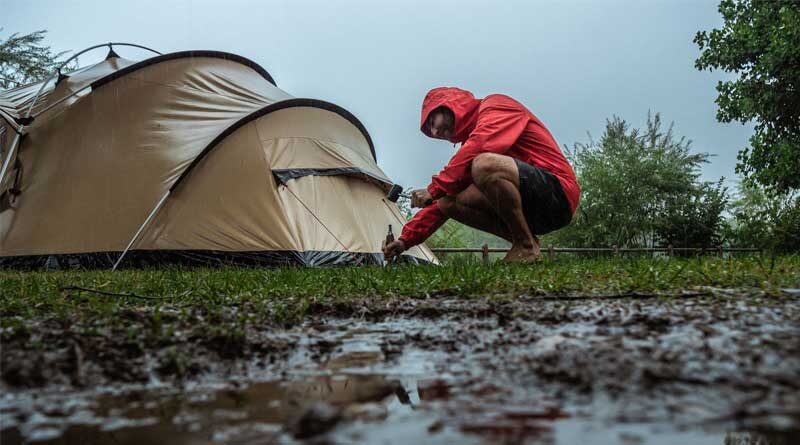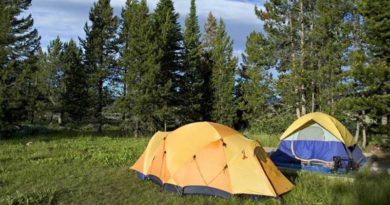7 Proven Ways to Keep your Tent Dry in the Rain
One of the biggest problems I hear about people getting wet when they’re camping. They sleep at night and a nice warm sleeping bag, it rains overnight and they wake up in a puddle of water inside their tent. This is, probably, one of the most common mishaps that can happen in the rain while camping. When you are camping, you can’t change things at the last minute just because of a little rain. So, what do you do? You’re going to have to figure out a different way to make sure that you stay dry and comfortable, while still pitching a tent in the great outdoors. Luckily, there are plenty of ways that you can do just that. You just need the right tools to help.
1. Choose the Right Site
The number one tip is to pitch your camping tent in the correct place. Pitch your tent up high on high ground where water is running off. I’ve seen old tents that do leak but stay fairly dry if they’re placed in the right position. I’ve also seen very high-end tents full of water because they were placed in the wrong spot. So, it’s not the quality of the tent so much as it is where you put it.
If you are out buying a new tent, there’re a couple of things you should look for. You want to make sure your tent has a nice what they call a bathtub bottom. The material of the floor doesn’t just go on the ground but it goes up on the sides and creates a bit of a barrier for water running in. You want a nice 3 to 6 inches of bathtub floor all around your tent. That fabric is usually a thicker fabric than the rest of the tent and that’s recommended the thicker it is the more waterproof it will be. But I’m getting away with a very thin floor. I have a light Big Agnes Copper Spur and it has a very thin floor.
2. Use a Groundsheet
This is a little controversial topic. A lot of folks that bring groundsheets put inside their tents and I see this works. The folks that do this many of them are very experienced. They bring a type of plastic groundsheet and they put it inside their tent. What they’re doing is recreating that bathtub bottom on the inside. If their tent gets wet, they’ve got a plastic barrier between the water and their sleeping gear, and that works for them. But if you put your tent in the right place you don’t have to do that.
Most of the time, the groundsheet goes on the ground, and then your tent goes on top of it. The ground fly needs to be made of waterproof material and it needs to be smaller than the bottom of your tent so that your tent doesn’t absorb water from the edges and into the center. Even if you’re not expecting rain it’s a good idea to use the groundsheet because there’s moisture in the ground that can be absorbed by your tent.
3. Use a Tarp
Another important step is to use a tarp or rain fly over the top of your tent. This will protect the top of the tent from rain that comes down rather than just coming up like the ground fly. This also works for areas that had rain where you could be faced with water dripping off the trees for hours or even days after the rain has stopped. Just make sure that your tarp is slanted downhill so that it rolls off the top and away from your tent.
4. Try a Seam Sealant
Just because your tent is considered waterproof doesn’t mean that it’s fully water-sealed. Using a seam sealant will get rid of the weak spots that are most likely to let in moisture and rain while you’re sleeping. Coat any holes or hems as well as around doors and windows or anywhere that opens on your tent. These are the spots that are going to be the weakest and cause you the most problems.
5. Use Water Repellant
This is another option to help keep out the rain and keep your tent as dry as possible. You spray the water repellant on the exterior of the tent to make sure that it’s well protected. This is going to help enhance the waterproof nature of the tent, which is going to make you feel a whole lot better and help the rain just roll off the outside of your tent the same way it would on a raincoat. That’s going to keep you feeling warm and dry inside.
6. Vent the Interior
You may not think about the fact that when you breathe it releases tiny droplets of vapor into the air. That vapor can actually cause condensation. It gets inside your tent and if it’s fully closed, up that’s going to cause moisture to build up in the tent throughout the night. Instead, make sure you leave a small vent of some type by leaving a door or window just a little open. This will allow that moisture to evaporate and keep it out of your tent, keeping you dry.
7. Choose a Clearing
Also in the process of choosing the right spot to camp, you want to select an area that’s in a clearing. You might think that it’s a good idea to stay under some type of cover, but that’s actually not the case. You’ll end up with rain coming down on you from the trees long after it actually starts raining. Plus, if it’s still storming and you have any kind of lightning it’s not going to be safe under the trees. You’re better off in a clearing away from the trees.
Stay Dry All-Around
Once you’ve figured out the best ways to keep your tent dry, it’s also important to keep yourself dry. That means staying inside the tent when possible. It also means that you have warm and dry clothes to wear at all times. Make sure that you choose clothing that is waterproof or at least your outer layers. These two things are very different and that will be even more obvious once you’re out in the rain.
Use a sleeping pad under your sleeping bag to add yet another layer between the ground and you. The ground fly will protect the bottom of the tent from moisture. The bottom of the tent will help protect you from moisture. But adding a sleeping pad gets you even further away from the wet ground. Also, it gets you up off the cold ground and adds another layer of insulation. This will keep you warmer and dryer throughout the night.
Make sure that you’re doing everything you can to keep your tent dry and then keep yourself dry inside of it. You’re going to feel a lot better and enjoy your trip a whole lot more if you have a dry tent, both inside and out. And you’ll definitely appreciate being warm and dry yourself in the process. All it takes is a little bit of planning to pick up some extra materials and you can keep your tent dry all night.




